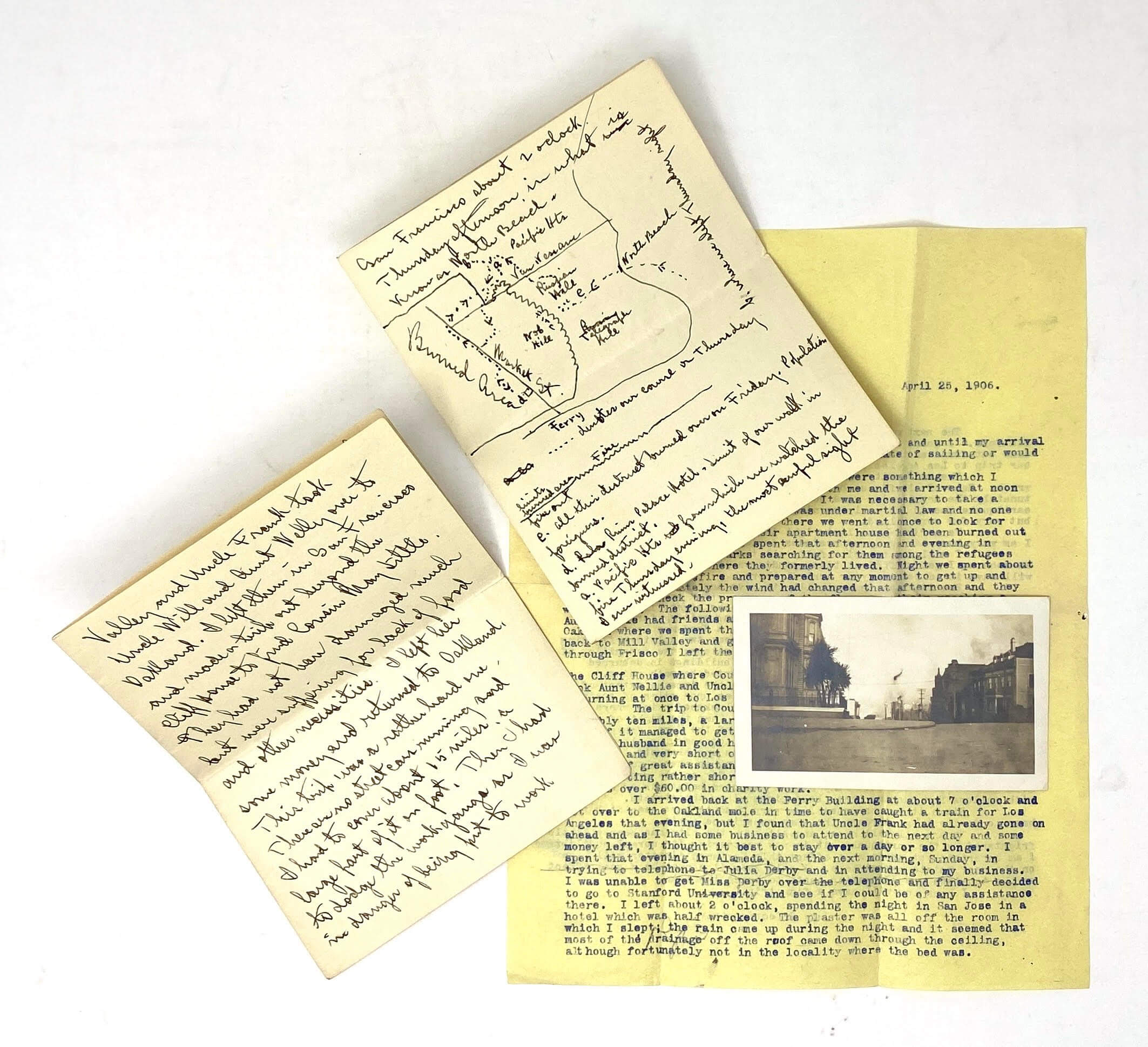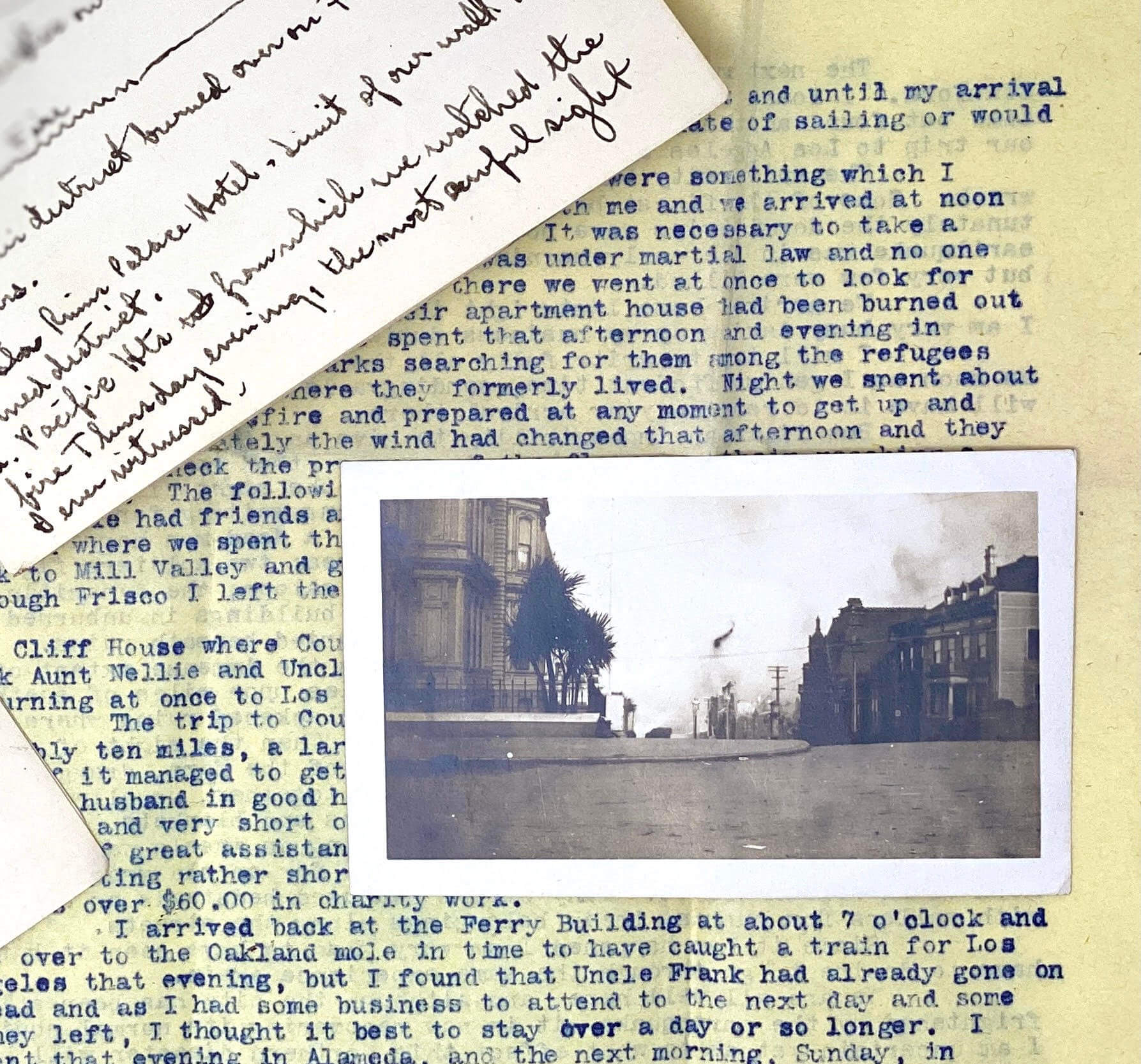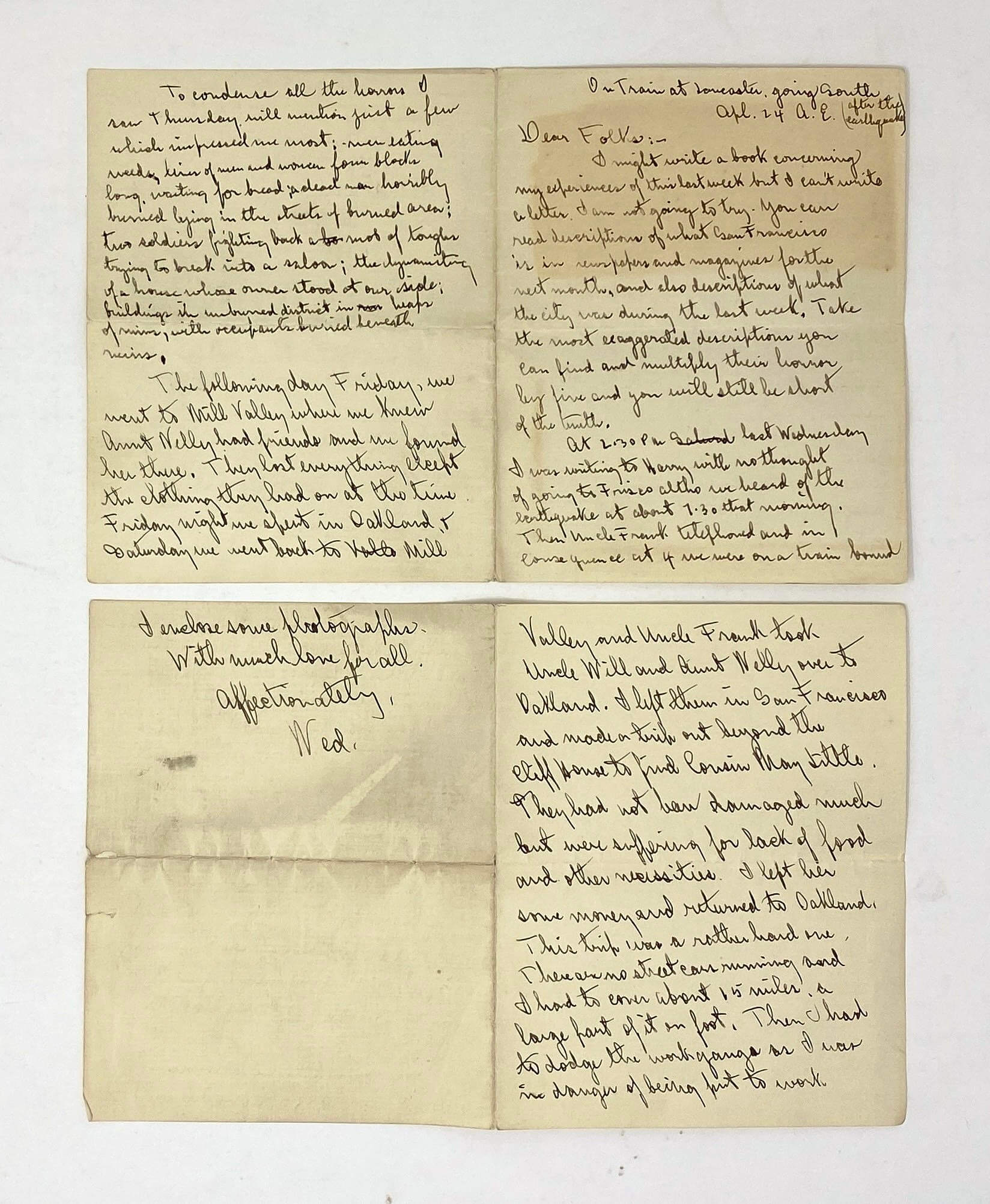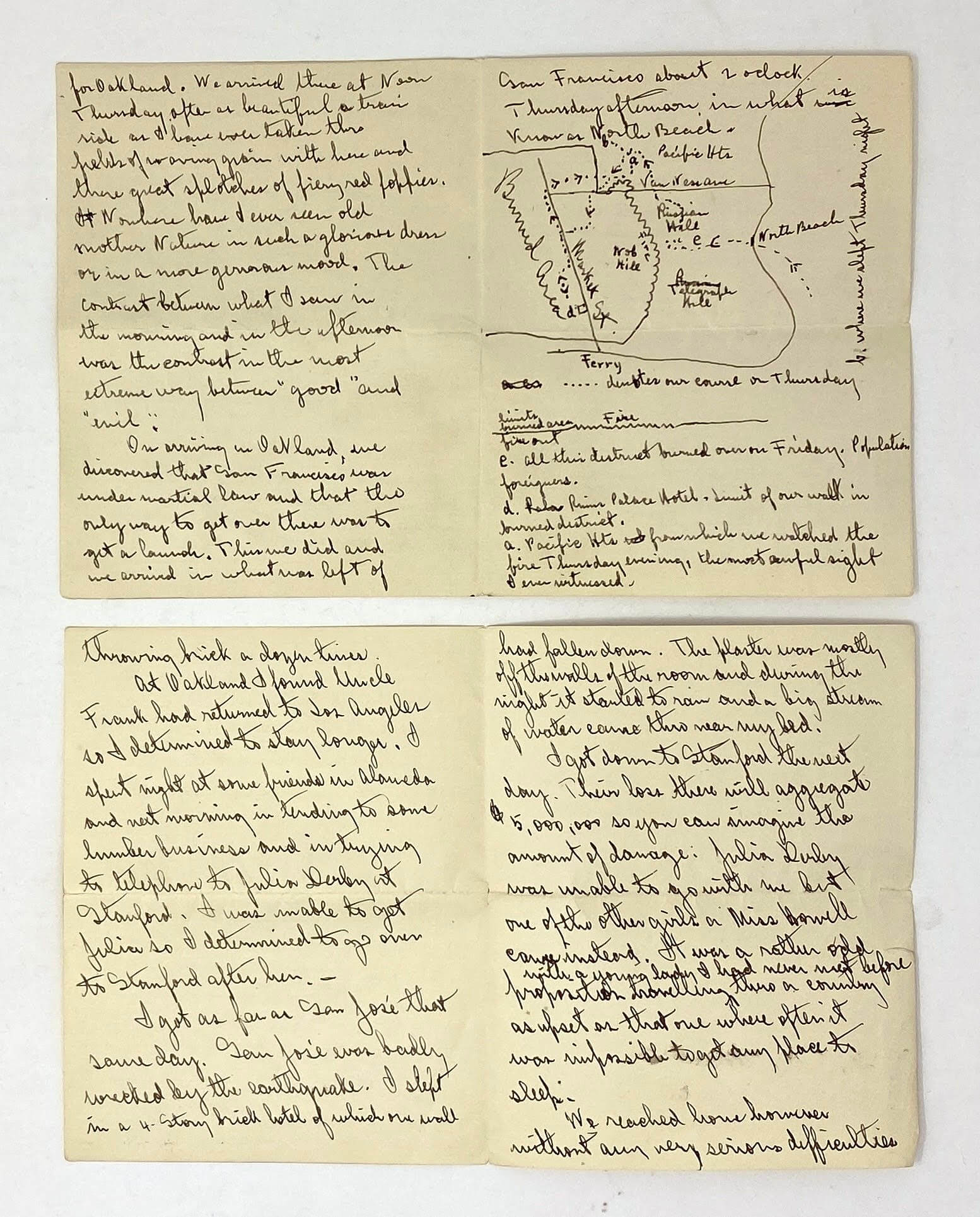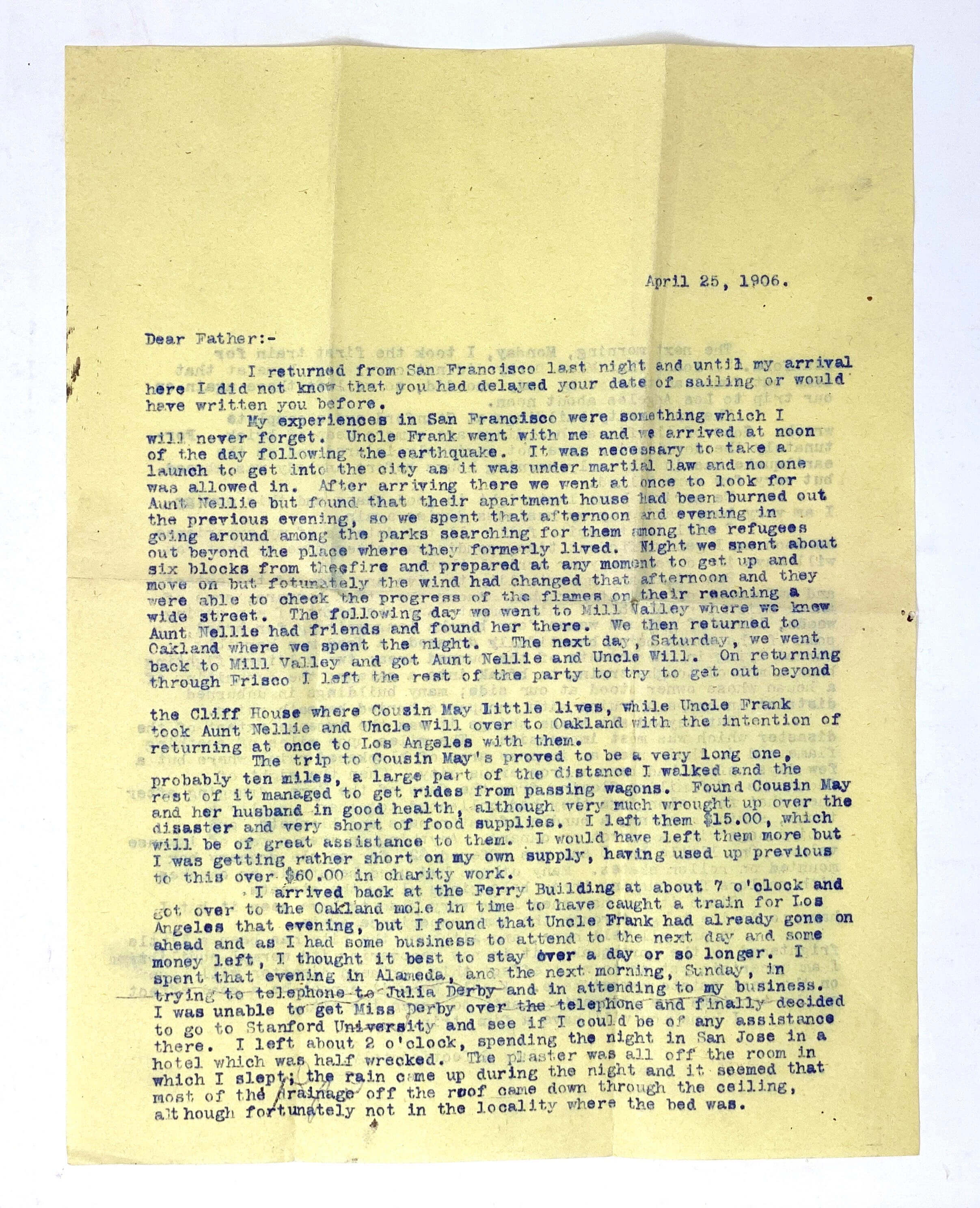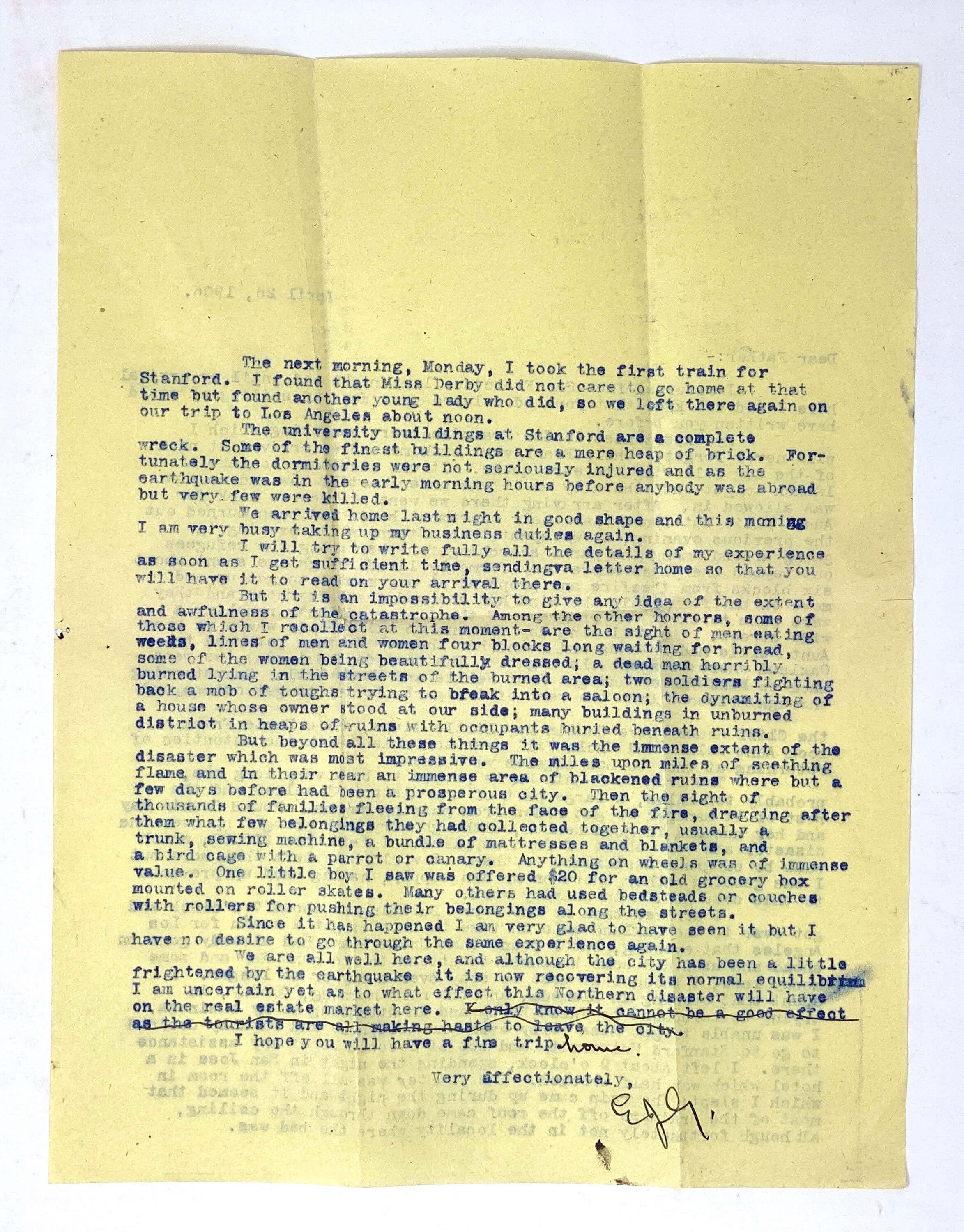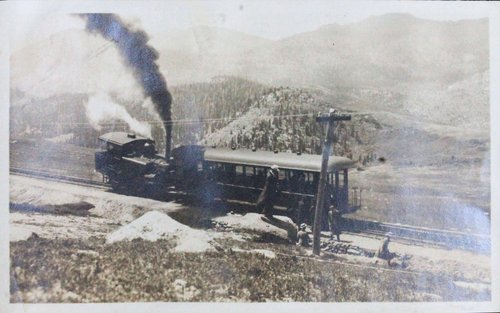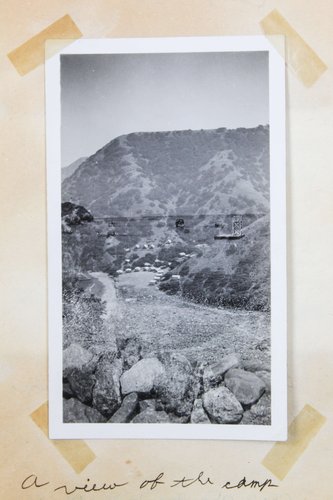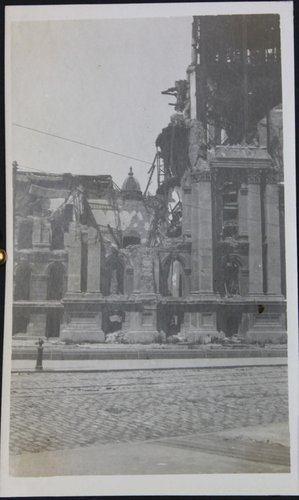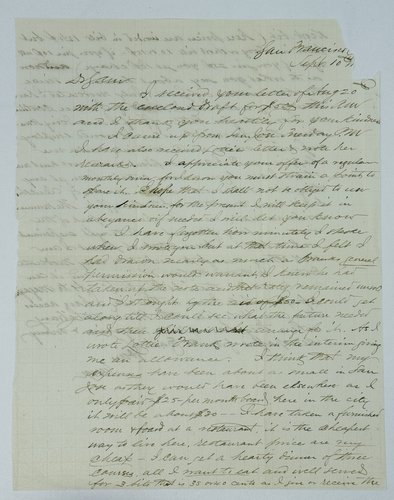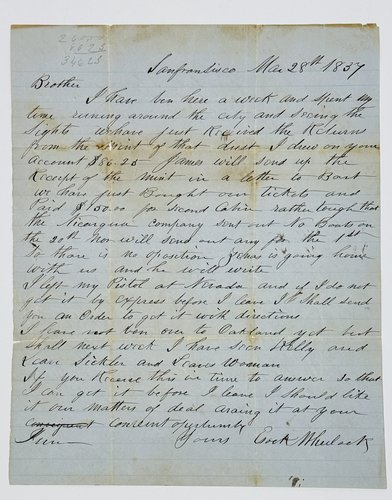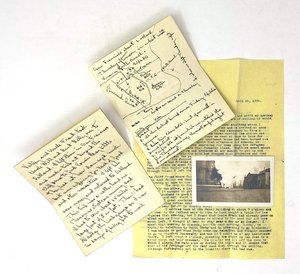
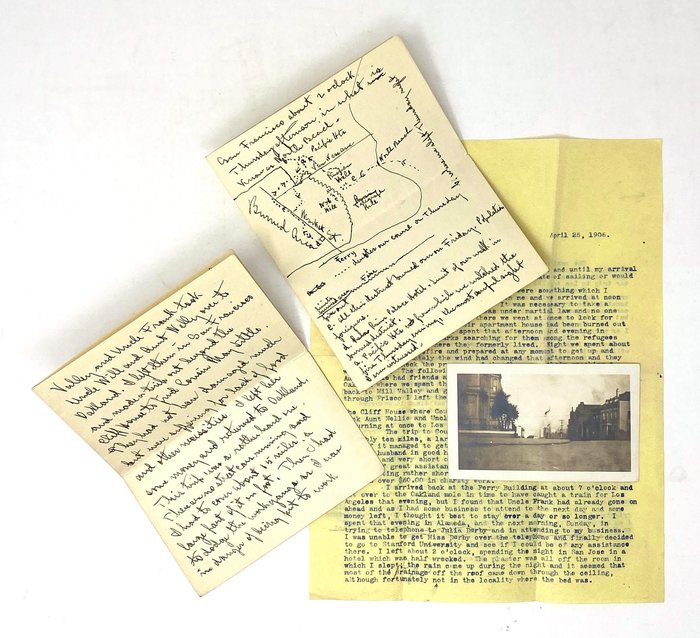
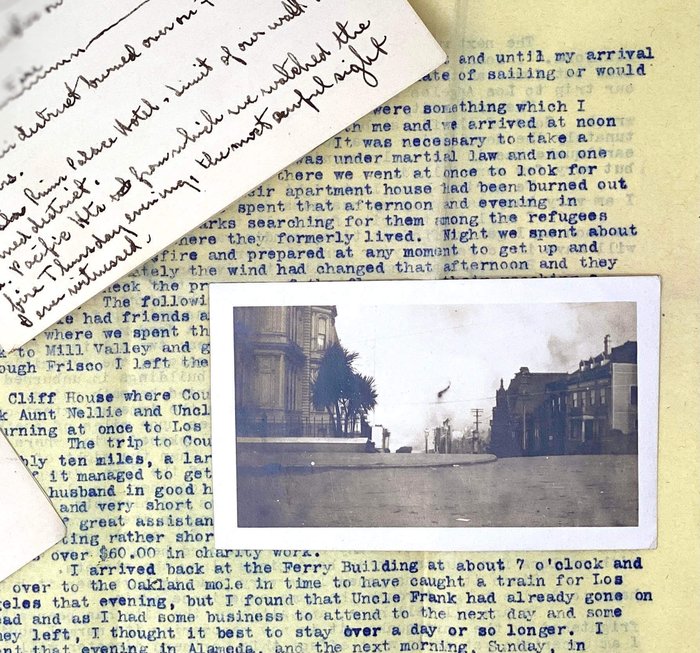
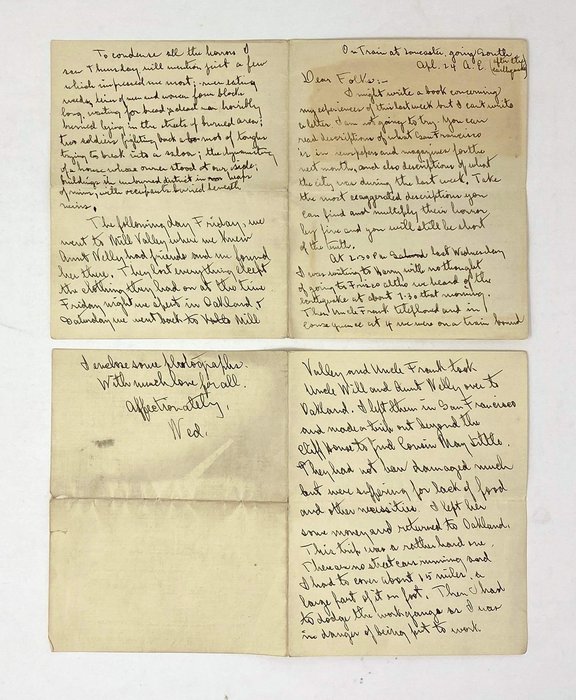
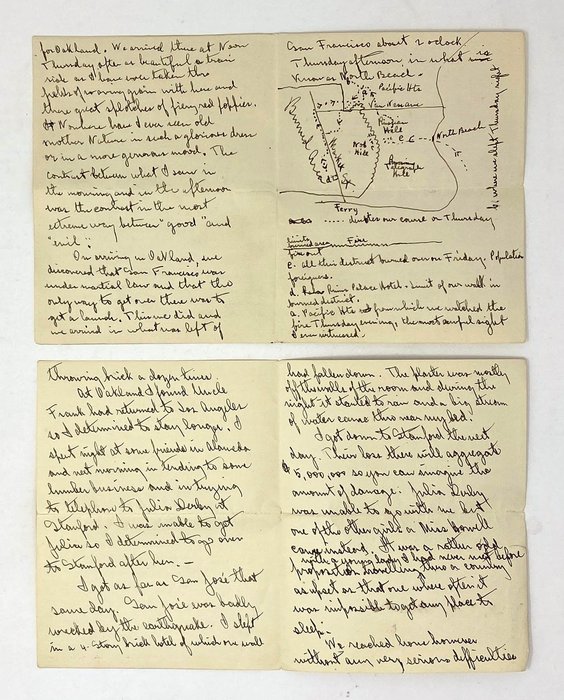
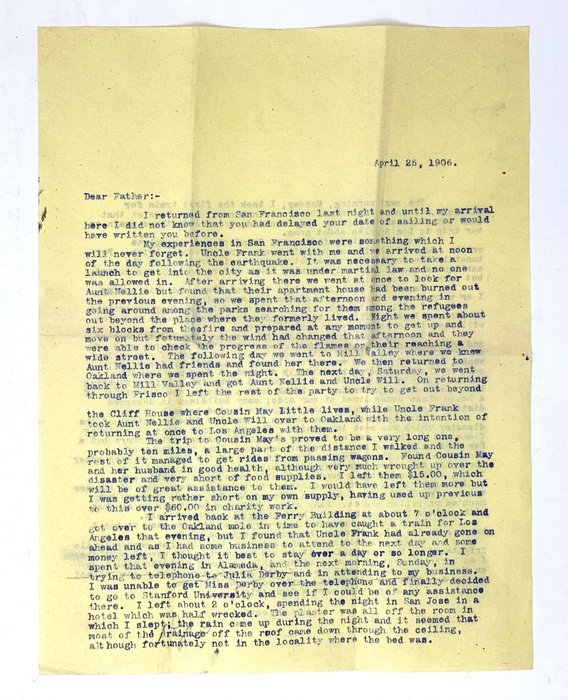
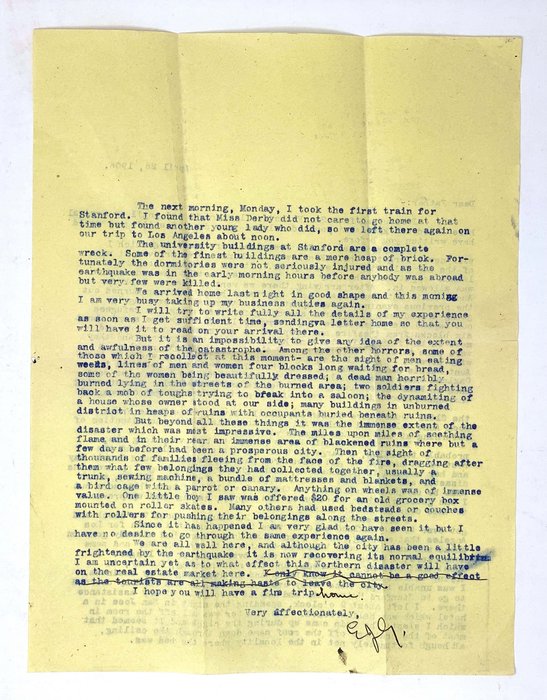
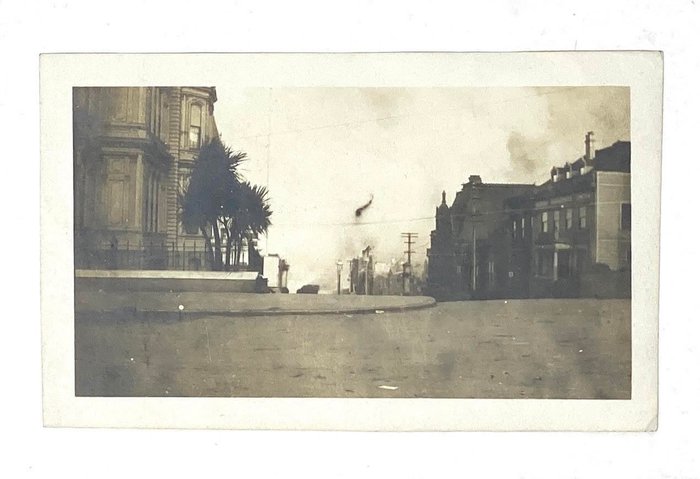
#MA41
April 1906
Manuscript letter pp. ca. 14 х 15.2 cm (5 ½ x 6 ½ in); typewritten letter pp. ca. 27.9 x 21.3 cm (10 ½ х 8 ¼ in); albumen photograph ca. 10.2 х 5.1 cm (4 ½ x 2 ½ in). Manuscript letter: brown ink on wove paper. Typewritten letter: blue text on yellow wove paper. Both letters with fold marks,
Dated 24 and 25 April 1906, the collection documents the horrors of one of the most devastating earthquakes in San Francisco as seen through the eyes of “E. J. G.,” a frightened witness to the disaster.
The letters were written only a few days after San Francisco experienced one of the severest earthquakes in the history of the United States. The quake and the subsequent fire killed an estimated 3,000 people and destroyed over 30,000 houses, leaving half of the city's 400,000 residents homeless.
The collection consists of an original content-rich autograph manuscript letter, a typewritten letter, and an unpublished albumen photograph. The letters were written on a train at Lancaster (possibly near Los Angeles) by an eyewitness to the disaster and addressed to his folks back home. According to the letters, the author was from Los Angeles and was engaged in the lumber business. He traveled by train and boat to San Francisco and its nearby areas to check on his relatives and examine levels of destruction five days after the disaster.
In the original autograph manuscript letter dated 24 April 1906, the author shockingly describes his search for affected friends and relatives in California and vividly portrays the damages inflicted upon San Francisco (“men eating weeds,” “a dead man lying in the street,” etc.), Mill Valley (“they lost everything”), San Jose (“badly wrecked by the earthquake”), and Stanford (“they lost a mill aggregate $5,000,000”). In the following passages, “E. J. G.” reports on the shortage of food supplies, the influx of marauders, and the destruction caused by the subsequent fire. The frightened author recounts “the most awful sight” he has ever seen and writes about “men eating weeds,” “lines of men and women waiting for bread,” casualties, etc. The author also mentions his relatives in Mill Valley, “who lost everything except the clothing they had on,” and writes about his cousin beyond the Cliff House (San Francisco) “suffering from lack of food.” Near the letter’s close, “E. J. G.” talks about dodging the work gangs in San Francisco and describes his troublesome stay in a quake-damaged hotel in San Jose.
Importantly, the letter includes a hand-drawn map with the author’s notes, showing San Francisco’s burned-down area between South of Market Street to North Beach and the Ferry and Pacific Heights.
The typewritten letter was written on 25 April 1906, almost immediately after the author arrived home. In the text, the letter writer gives a similar account of the earthquake with additional details on the damages inflicted upon Stanford University, panic amongst the fleeing people, his search for relatives among the refugees, his charity work, etc.
The collection also includes an unpublished albumen photo depicting the environs of Van Ness Avenue, one of the most affected parts of the city, during the fire.
Overall, a historically important collection depicting one of the most devastating earthquakes in San Francisco as seen through the eyes of a frightened eyewitness.
The text of the manuscript letter (original spelling and punctuation preserved):
“I might write a book concerning my experience of this last week but I can’t write a letter. I am not going to try. You can read descriptions of what San Francisco is in newspapers and magazines for the next month, and also descriptions of what the city was during the last week. Take the most exaggerated description you can find and multiply their horror by five and you will still be short of the truth.
At 2.30 pm last Wednesday I was writing to Harry with no thought of going to Frisco altho we heard of the earthquake at about 7.30 that morning. Then Uncle Frank telephoned and in consequence at 4 we were on a train bound for Oakland. We arrive there at Noon Thursday after as beautiful train – as I have – taken thro fields of waving grin with here and there - - of - - . At nowhere have I ever seen old mother Nature in such a glorious dress or in a more generous mood. The contrast between what I saw in the morning and in the afternoon was the contrast in the most extreme way between “good” and “evil.”
On arriving in Oakland, we discovered that San Francisco was under martial law and the only way to get over there was to get a launch. This we did and we arrived in what was left of San Francisco about 2 o’clock Thursday afternoon, in what is known as North Beach.
e) all this district burned over on Friday. Population foreigners.
d) Ruins Palace Hotel. Limit of our walk in burned district.
a) Pacific Hts from which we watched the fire Thursday evening, the most awful sight I ever witnessed.
To condense all the horrors I saw Thursday will mention first a few which impressed me most: men eating weeds, lines of men and women four blocks long, waiting for bread; a dead man horribly burned lying in the streets of burned area; two soldiers fighting back a mob of toughs trying to break into a saloon; the dynamiting of a house whose owner stood at our side; buildings in unburned district in heaps of ruins, with occupants buried beneath ruins.
The following day Friday we went to Mill Valley where we knew Aunt Nelly had friends and we found her there. They lost everything except the clothing they had on at the time. Friday night we spent in Oakland, Saturday we went back to Mill Valley and Uncle Frank took Uncle Will and Aunt Nelly over to Oakland. I left them in San Francisco and made a trip out beyond the Cliff House to find Cousin May Little. They have not been damaged much but were suffering for lack of food and other necessities. I left her some money and returned to Oakland. This trip was a rather hard one. There are no street cars running and I had to cover about 15 miles, a large part of it on foot. Then I had to dodge the work gang as I was in danger of being put to work throwing brick a – times.
At Oakland I found Uncle Frank had returned to Los Angeles so I determined to stay longer. I spent night at some friends in alameda and next morning in tending to some lumber business and in trying to telephone to Julia Derby at Stanford. I was unable to get Julia so I determined to go over to Stanford after her.
I got as far as San Jose that same day. San Jose was badly wrecked by the earthquake. I slept in a 4-story brick hotel of which one wall had fallen down. The plaster was mostly off the walls of the room and during the night it started to rain and a big stream of water came thru – my bed.
I got down to Stanford the next day. Their loss there mill aggregate $5,000,000 so you can imagine the amount of damage: Julia Derby was unable to go with me but one of the other girls a Miss – came instead. It was a rather odd proposition indwelling thus a country as upset as that one where often it was impossible to get any place to sleep.”
The text of the typewritten letter:
“I returned from San Francisco last night and until my arrival here I did not know that you had delayed your date of sailing or would have written you before.
My experiences in San Francisco were something which I will never forget. Uncle Frank went with me and we arrived at noon of the day following the earthquake. It was necessary to take a launch to get into the city as it was under martial law and no one was allowed in. After arriving there we went at once to look for Aunt Nellie but found that their apartment house had been burned out the previous evening, so we spent that afternoon and evening in going around among the parks searching for them among the refugees out beyond the place where they formerly lived. Night we spent about six blocks from the fire and prepared at any moment to get up and move on but fortunately the wind had changed that afternoon and they were able to check the progress of the flames on their reaching a wide street. The following day we went to Mill Valley where we knew Aunt Nellie had friends and found her there. We then returned to Oakland where we spent the night. The next day, Saturday, we went back to Mill Valley and got Aunt Nellie and Uncle Will. On returning through Frisco I left the rest of the party to try to get out beyond the Cliff House where Cousin May Little lives, while Uncle Frank took Aunt Nellie and Uncle Will over to Oakland with the intention of returning at once to Los Angeles with them.
The trip to Cousin May’s proved to be a very long one, probably ten miles, a large part of the distance I walked and the rest of it managed to get rides from passing wagons. Found Cousin May and her husband in good health, although very much vrought up over the disaster and very short of food supplies. I left them $15.00, which will be of great assistance to them. I would have left them more but I was getting rather short on my own supply, having used up previous to this over $60.00 in charity work.
I arrived back at the Ferry Building at about 7 o’clock and got over to the Oakland mole in time to have caught a train for Los Angeles that evening, but I found that Uncle Frank had already gone on ahead and as I had some business to attend to the next day and some money left, I thought it best to stay over a day or so longer. I spent that evening in Alameda, and the next morning, Sunday, in tryin to telephone to Julia Derby and in attending to my business. I was unable to get Miss Derby over the telephone and finally decided to go to Stanford University and see if I could be of any assistance there. I left about 2 o’clock, spending the night in San Jose in a hotel which was half wrecked. The plaster was all off the room in which I slept; the rain came up during the night and it seemed that most of the drainage off the roof came down through the ceiling, although fortunately not in the locality where the bed was.
The next morning, Monday, I took the first train for Stanford. I found that Miss Derby did not care to go home at that time but found another young lady who did, so we left there again on our trip to Los Angeles about noon.
The university buildings at Stanford are a complete wreck. Some of the finest buildings are a mere heap of brick. Fortunately the dormitories were not seriously injured and as the earthquake was in the early morning hours before anybody was abroad but very few were killed.
We arrived home last night in good shape and this morning I am very busy taking up my business duties again.
I will try to fully write all the details of my experience as soon as I get sufficient time, sendingya letter home so that you will have it to read on your arrival there.
But it is an impossibility to give you any idea of the extent and awfulness of the catastrophe. Among the other horrors, some of those which I recollect at this moment - are the eight of men eating weeds, lines of men and women four blocks long waiting for bread, some of the women being beautifully dressed; a dead man horribly burned lying in the streets of the burned area; two soldiers fighting back a mob of toughs trying to break into a saloon; the dynamiting of a house whose owner stood at our side; many buildings in unburned district in heaps of ruins with occupants buried beneath ruins.
But beyond all these things it was the immense extent of the disaster which was most impressive. The miles upon miles of seething flame and in their rear an immense area of blackened ruins where but a few days before had been a prosperous city. Then the sight of thousands of families fleeing from the face of the fire, dragging after them what few belongings they had collected together, usually a trunk, sewing machine, a bundle of mattresses and blankets, and a bird cage with a parrot or canary. Anything on wheels was of immense value. One little boy I saw was offered $20 for an old grocery box mounted on roller skates. Many others had used bedsteads or couches with rollers for pushing their belongings along the streets.
Since it has happened I am very glad to have seen it but I have no desire to go through the same experience again.
We are all well here, and although the city has been a little frightened by the earthquake it is now recovering its normal equilibrium. I am uncertain yet as to what effect this Northern disaster will have on the real estate market here. I only know it cannot be a good effect as the tourists are all making haste to leave the city.
I hope you will have a fine trip home.”

